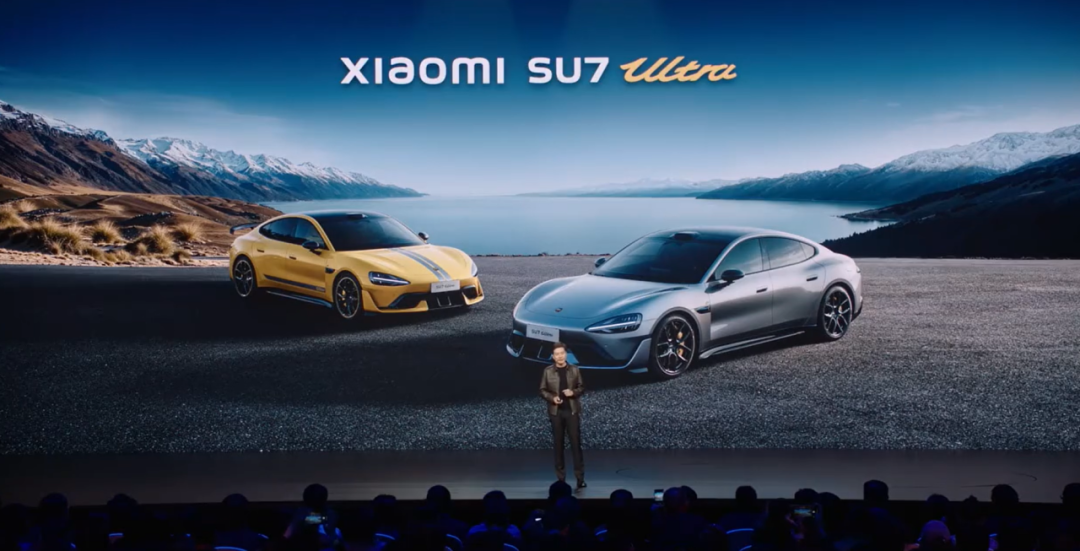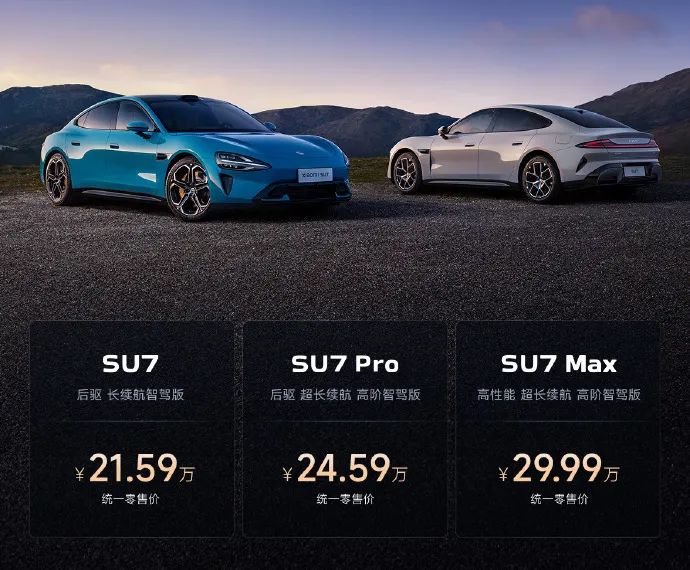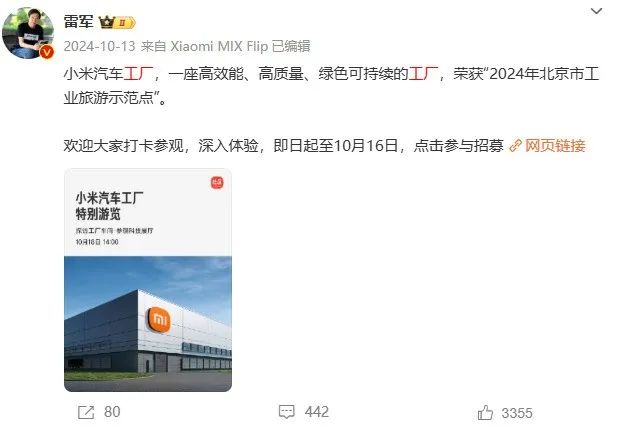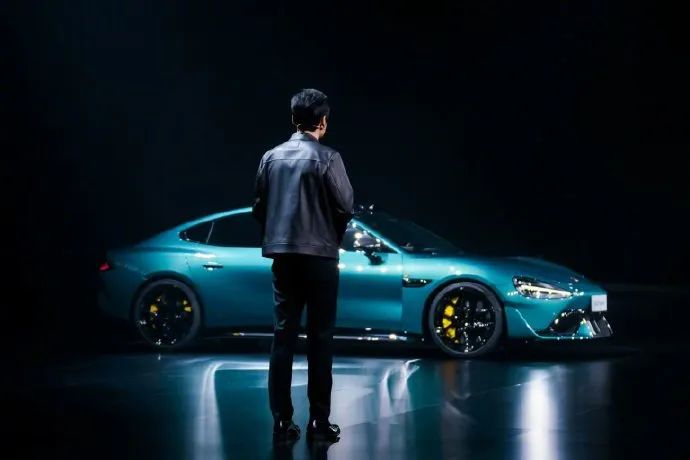Xiaomi Leverages Domestic Supply Chain to Rival Apple
![]() 03/25 2025
03/25 2025
![]() 750
750
Source | YuanSight
The Xiaomi Automobile press conference was a spectacle, resembling more a grand fan festival than a typical new car launch. Lei Jun, Xiaomi's founder, stood center stage, his iconic attire or imitation of Huang Renxun's leather jacket always propelling him to the top of online search trends.

Screenshot from Xiaomi SU7 Ultra new product press conference
Lei Jun excels at invoking the phrase "All in," which ignites the passions of Xiaomi fans. Following the event, orders surged, Xiaomi's share price climbed, and the company presented its strongest financial report ever. Lei Jun once again became the focal point of public opinion.
Yet, this time, the tide of public sentiment appears to have shifted.
In the past, when Lei Jun ventured into the mobile phone industry, the phrase "Standing on the cusp of a trend, even pigs can fly" was seen as opportunistic, and "Are you OK" transformed into a viral meme. He was nicknamed "Leibusi," a follower closely mimicking Apple.
Now, on one side, there's the remarkable market buzz surrounding Xiaomi Automobile, and on the other, Apple's long-unfulfilled dream of vehicle manufacturing. Public opinion is re-evaluating the strategic choices of these two giants.
More importantly, what underpins Lei Jun's confidence is no longer mere sentiment and marketing but a meticulously crafted "investment banking-style manufacturing" logic, coupled with the ascendancy of China's supply chain.
01 Lei Jun's Frantic Dash
Each Xiaomi Automobile press conference is less about product unveilings and more about a meticulously orchestrated "Lei Jun personal IP" show.
From pre-event warm-ups, to meticulous on-site control, to post-event public opinion management, every aspect precisely taps into the flow of traffic.
Lei Jun personally road-tested the SU7, frequently interacted with users on social media, and even adopted a "listen first, then adapt" pricing strategy, fully engaging user emotions and expectations.
It must be acknowledged that Lei Jun is adept at internet marketing and accurately captures the emotional needs of Xiaomi fans. Phrases like "The last battle of my life" stir countless hearts, and "99,000 yuan is impossible, forget about 149,000 yuan" instantly sparks users' buying desires.
Ultimately, Xiaomi SU7 entered the market with a starting price of 215,900 yuan. It seems like a "steal," but it's actually a clever marketing ploy. This price avoids direct competition with rivals like the Tesla Model 3 while anchoring users' psychological expectations that "Xiaomi Automobile is not expensive."

Data confirms the success of "Lei Jun-style marketing." Post-event, Xiaomi Automobile orders were lengthy, and social media discussions remained high. Topics like "#Lei Jun SU7#" swiftly topped trending lists.
However, beneath the flurry of initial excitement, we must remain composed.
The popularity of initial orders is indeed gratifying, but disentangling how much is due to Lei Jun's personal IP, how much to early adopters' impulse buying, and how much can be converted into long-term stable sales requires time.
After all, cars differ from mobile phones. Their low-frequency consumption nature means user decisions are more rational, focusing on product reputation and service experience.
Whether Xiaomi Automobile can sustain this "frantic dash" momentum and secure a foothold in fierce market competition ultimately hinges on the product itself and the supply chain system behind it.
02 Confidence in Made in China
If "Lei Jun-style marketing" is the face of Xiaomi Automobile's remarkable start, then "China's supply chain" is the confidence that fuels its frantic dash.
Lei Jun's confidence is not blind but rooted in years of deep insight and strategic layout of China's supply chain.
Long before Xiaomi officially announced its foray into vehicle manufacturing, Lei Jun and Xiaomi had begun investing and laying the groundwork around the intelligent electric vehicle industry chain.
From CATL and BYD in power batteries to NVIDIA and Horizon Robotics in autonomous driving chips, and Hesai Technology and RoboSense in LiDAR, Xiaomi has invested in virtually all key enterprises in critical links of the intelligent electric vehicle industry chain.
This phased victory in betting on the domestic supply chain was evident in the 2024 financial report: automotive business annual revenue hit 32.8 billion yuan, the gross margin in the fourth quarter surged to 20.4%, and the net loss narrowed to 700 million yuan.
In fact, this "investment banking-style manufacturing" logic is not unique to Xiaomi but has been taken to an extreme by the company.
The traditional automotive manufacturing model involves defining the product first and gradually building the supply chain system. In contrast, "investment banking-style manufacturing" reverses this process. It invests heavily in the early stages to lay out the industrial chain, waits for it to mature, and then integrates resources to swiftly launch products.
This model's advantage lies in fully leveraging the maturity and scale effects of the existing industrial chain, significantly reducing R&D and trial-and-error costs, and shortening the product launch cycle.
Particularly in China, which boasts the world's most comprehensive automotive industrial chain, the advantages of "investment banking-style manufacturing" are further amplified.
Lei Jun and Xiaomi's chips are neither the 1.98-second zero-to-hundred acceleration on the Xiaomi SU7 Ultra specification sheet nor the rotatable central control screen. In the mold workshops of the Yangtze River Delta, the battery laboratories of the Pearl River Delta, and the intelligent driving data centers of Beijing-Tianjin-Hebei, an invisible front that has been dormant for a decade is emerging. Starting with investments in automotive chip companies in 2014, Lei Jun has utilized the supply chain integration techniques honed in the mobile phone industry to replicate an even grander "blitzkrieg" in the automotive sector.
While international giants ponder whether to build their own factories, Xiaomi Automobile has transformed China's 40 years of industrialization accumulation into mass production speed through the precise collaboration of hundreds of core suppliers and strategic investment enterprises.
Lei Jun believes that China's supply chain is sufficient to support Xiaomi's vehicle manufacturing dream.

Screenshot from Weibo @Lei Jun
The robust sales of Xiaomi Automobile SU7 also validate Lei Jun's assessment.
From body structural parts to interior and exterior trims, from the three-electric system to the intelligent cockpit, almost all Xiaomi SU7 components can find mature solutions in China's supply chain. This allows Xiaomi Automobile to maximize cost control and achieve rapid mass production while ensuring product performance and quality.
Of course, "investment banking-style manufacturing" is not without risks. In the short term, this model can help Xiaomi Automobile rise swiftly, but in the long run, its sustainability faces numerous challenges.
Over-reliance on a single market may limit Xiaomi Automobile's globalization. Insufficient technological innovation capability may put it at a disadvantage in future competition. Supply chain security risks may also cast a shadow over Xiaomi Automobile's growth at any time.
Especially as the global automotive industry accelerates its transformation towards electrification and intelligence, and as new technological paradigms and business models continue to emerge, there remains uncertainty as to whether Xiaomi Automobile can maintain its competitiveness and avoid becoming a mere "assembly plant."
03 Breaking Through Apple
As Lei Jun goes all in on vehicle manufacturing and benchmarks Xiaomi Automobile against Porsche and Tesla, an unavoidable point of comparison is Apple.
As technology giants with strong brand appeal and user bases, and ambitions in the automotive industry, rumors of Apple making cars have circulated longer than those of Xiaomi, yet no substantial products have materialized.
According to rumors, Apple's vehicle manufacturing project "Titan" has been restarted multiple times, beset by severe team infighting, uncertain technical routes, and inadequate supply chain control, ultimately leading to repeated delays in the vehicle manufacturing plan.
An important reason is Apple's closed and controlling genes.
Apple is accustomed to controlling the entire industrial chain, striving for ultimate self-sufficiency and controllability from chip design to software ecology. This model has achieved great success in the consumer electronics field but seems misplaced in the automotive field, where the industrial chain is extremely complex and open collaboration is crucial.
Apple has always attempted to replicate its consumer electronics supply chain model into the automotive field, but the results have been disappointing. It relies heavily on overseas supply chains, particularly suppliers from Japan, South Korea, and Europe, and appears somewhat estranged from China, the world's largest automotive parts production base.
This supply chain strategy may have been sustainable in the early stages, but as China's new energy automotive industry chain rises, Apple's disadvantages become increasingly apparent.
The automotive industry chain is far longer and more complex than that of mobile phones. Even Tesla cannot fully achieve self-sufficiency and controllability of components, let alone Apple, which lacks experience in automobile manufacturing.
Xiaomi's advantage lies in being more open and pragmatic.
Xiaomi is acutely aware of its shortcomings in the automotive field and chooses to deeply integrate with the industrial chain, fully leveraging China's supply chain advantages to swiftly compensate for deficiencies and achieve overtaking in curves.
This open and collaborative attitude forms a stark contrast with Apple's closed control.
The capital market's keen sense confirms the potential of this model. On the day Xiaomi Automobile officially announced mass production, the share prices of over ten supply chain enterprises such as Ningbo Xusheng Group and Changzhou Xingyu Co., Ltd. surged to the daily limit, reflecting the capital market's revaluation of new supply relationships. In contrast, Apple's conservative "black box procurement" strategy in the automotive field has prevented it from establishing an absolute discourse power akin to that in the consumer electronics field.
More interestingly, when Lei Jun entered the mobile phone industry, he was mocked as "Leibusi." The title "Leibusi" also carried some ironic undertones. Now, however, Xiaomi Automobile seems to be ahead of Apple, having taken the lead in launching a popular model.

Image from Weibo @Lei Jun
A year ago, when Lei Jun drove the Xiaomi SU7 into the press conference venue in Yizhuang, Beijing, he may have recalled the afternoon fourteen years ago when he stood in the 798 Art District to launch the first-generation Xiaomi mobile phone.
For Lei Jun, this is not just a victory for Xiaomi but also for China's supply chain.
This may reveal a new reality: As international brands debate whether to relocate their supply chains out of China, China's new energy industry chain has evolved into a self-iterating ecosystem. Those enterprises once deemed "followers" are now converting manufacturing advantages into technological discourse power through countless Xiaomi-style networked alliances.
Some images are sourced from the internet. Please inform us for deletion if there is any infringement.







